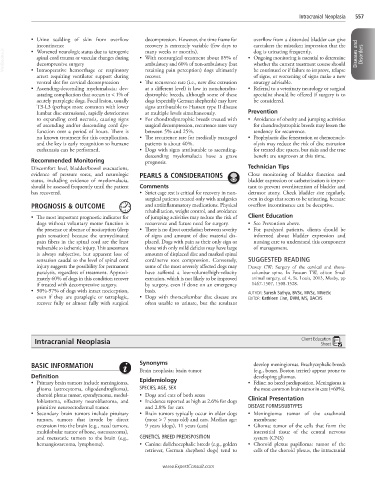Page 1116 - Cote clinical veterinary advisor dogs and cats 4th
P. 1116
Intracranial Neoplasia 557
• Urine scalding of skin from overflow decompression. However, the time frame for overflow from a distended bladder can give
incontinence recovery is extremely variable (few days to caretakers the mistaken impression that the
VetBooks.ir spinal cord trauma or vascular changes during • With nonsurgical treatment about 85% of • Ongoing monitoring is essential to determine Diseases and Disorders
many weeks or months).
dog is urinating frequently.
• Worsened neurologic status due to iatrogenic
ambulatory and 60% of non-ambulatory (but
whether the current treatment course should
decompressive surgery
• Intraoperative hemorrhage or respiratory
of signs, or worsening of signs make a new
arrest requiring ventilator support during retaining pain perception) dogs ultimately be continued or if failure to improve, relapse
recover.
ventral slot for cervical decompression • The recurrence rate (i.e., new disc extrusion strategy advisable.
• Ascending-descending myelomalacia: dev- at a different level) is low in nonchondro- • Referral to a veterinary neurology or surgical
astating complication that occurs in < 1% of dystrophic breeds, although some of these specialist should be offered if surgery is to
acutely paraplegic dogs. Focal lesion, usually dogs (especially German shepherds) may have be considered.
T3-L3 (perhaps more common with lower signs attributable to Hansen type II disease
lumbar disc extrusions), rapidly deteriorates at multiple levels simultaneously. Prevention
to expanding cord necrosis, causing signs • For chondrodystrophic breeds treated with • Avoidance of obesity and jumping activities
of ascending and/or descending cord dys- surgical decompression, recurrence rates vary for chondrodystrophic breeds may lessen the
function over a period of hours. There is between 5% and 25%. tendency for recurrence.
no known treatment for this complication, • The recurrence rate for medically managed • Prophylactic disc fenestration or chemonucle-
and the key is early recognition so humane patients is about 40%. olysis may reduce the risk of disc extrusion
euthanasia can be performed. • Dogs with signs attributable to ascending- for treated disc spaces, but risks and the true
descending myelomalacia have a grave benefit are unproven at this time.
Recommended Monitoring prognosis.
Discomfort level, bladder/bowel evacuations, Technician Tips
evidence of pressure sores, and neurologic PEARLS & CONSIDERATIONS Close monitoring of bladder function and
status, including evidence of myelomalacia, bladder expression or catheterization is impor-
should be assessed frequently until the patient Comments tant to prevent overdistention of bladder and
has recovered. • Strict cage rest is critical for recovery in non- detrusor atony. Check bladder size regularly,
surgical patients treated only with analgesics even in dogs that seem to be urinating, because
PROGNOSIS & OUTCOME and antiinflammatory medications. Physical overflow incontinence can be deceptive.
rehabilitation, weight control, and avoidance
• The most important prognostic indicator for of jumping activities may reduce the risk of Client Education
dogs without voluntary motor function is recurrence and future need for surgery. • See Prevention above.
the presence or absence of nociception (deep • There is no direct correlation between severity • For paralyzed patients, clients should be
pain sensation) because the unmyelinated of signs and amount of disc material dis- informed about bladder expression and
pain fibers in the spinal cord are the least placed. Dogs with pain as their only sign or nursing care to understand this component
vulnerable to ischemic injury. This assessment those with only mild deficits may have large of management.
is always subjective, but apparent loss of amounts of displaced disc and marked spinal
sensation caudal to the level of spinal cord cord/nerve root compression. Conversely, SUGGESTED READING
injury suggests the possibility for permanent some of the most severely affected dogs may Dewey CW: Surgery of the cervical and thora-
paralysis, regardless of treatment. Approxi- have suffered a low-volume/high-velocity columbar spine. In Fossum TW, editor: Small
mately 60% of dogs in this condition recover extrusion, which is not likely to be improved animal surgery, ed 4, St. Louis, 2013, Mosby, pp
if treated with decompressive surgery. by surgery, even if done on an emergency 1467-1507, 1508-1528.
• 90%-97% of dogs with intact nociception, basis. AUTHOR: Suresh Sathya, BVSc, MVSc, MVetSc
even if they are paraplegic or tetraplegic, • Dogs with thoracolumbar disc disease are EDITOR: Kathleen Linn, DVM, MS, DACVS
recover fully or almost fully with surgical often unable to urinate, but the resultant
Intracranial Neoplasia Client Education
Sheet
BASIC INFORMATION Synonyms develop meningiomas. Brachycephalic breeds
Brain neoplasia; brain tumor (e.g., boxer, Boston terrier) appear prone to
Definition developing gliomas.
• Primary brain tumors include meningioma, Epidemiology • Feline: no breed predisposition. Meningioma is
glioma (astrocytoma, oligodendroglioma), SPECIES, AGE, SEX the most common brain tumor in cats (≈60%).
choroid plexus tumor, ependymoma, medul- • Dogs and cats of both sexes Clinical Presentation
loblastoma, olfactory neuroblastoma, and • Incidence reported as high as 2.6% for dogs
primitive neuroectodermal tumor. and 2.8% for cats DISEASE FORMS/SUBTYPES
• Secondary brain tumors include pituitary • Brain tumors typically occur in older dogs • Meningioma: tumor of the arachnoid
tumors, tumors that invade by direct (most > 7 years old) and cats. Median age: membrane
extension into the brain (e.g., nasal tumors, 9 years (dogs), 11 years (cats) • Glioma: tumor of the cells that form the
multilobular tumor of bone, osteosarcoma), interstitial tissue of the central nervous
and metastatic tumors to the brain (e.g., GENETICS, BREED PREDISPOSITION system (CNS)
hemangiosarcoma, lymphoma). • Canine: dolichocephalic breeds (e.g., golden • Choroid plexus papilloma: tumor of the
retriever, German shepherd dogs) tend to cells of the choroid plexus, the intracranial
www.ExpertConsult.com

